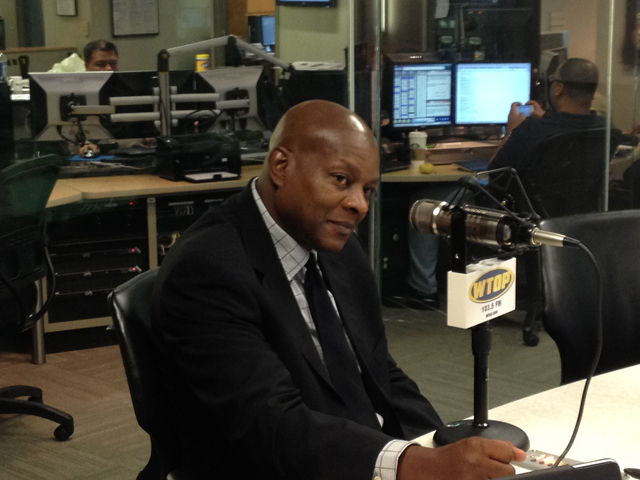WASHINGTON — The recent pipe bombs never exploded, but the damage was severe, according to retired police chief Charles Moose, who 16 years ago this week fronted the effort to capture two snipers who murdered 10 people in Maryland, Virginia, and the District of Columbia.
In October 2002, Moose was in his third year as chief of the Montgomery County, Maryland police department when John Allen Muhammad and Lee Boyd Malvo teamed up to terrorize the region by gunning down innocent citizens from the trunk of a 1990 Chevrolet Caprice.
Moose told WTOP how he felt last week, as more than a dozen pipe bombs were mailed to high-profile Democrats and critics of President Donald Trump over several days.
“That sense of evil — it’s so premeditated and planned,” said Moose. None of the devices exploded.
On Friday, the Department of Justice charged 56-year-old Cesar Sayoc with five federal crimes, including interstate transportation of explosives, illegal mailing of explosives, threats against interstate communications, assault on current and former federal officers, and threats against former presidents. He faces a maximum of 48 years in prison.
Moose said perpetrators who commit a series of crimes have a misguided determination.
“They have that much anger and have no other way to vent themselves, except to plan to do harm to a number of people. People they haven’t met, people they really know nothing about, yet they’re so committed they work on this for a number of days, if not weeks, or months.”
Muhammad and Malvo were both convicted of capital murder charges in Virginia in 2003. Muhammad was executed in 2009. Malvo is serving life sentences for convictions in Virginia and Maryland.
The victims of the Beltway Snipers were innocent strangers to Muhammad and Malvo — some were killed while pumping gas, mowing a lawn, and shopping.
Moose said the targets of the recent bomb mailings likely didn’t feel the same fear of the unknown that the victims in the sniper shootings felt.
“I’m not sure how much of an impact it had on someone like President Obama, who in the last 10 years had all kind of threats on his life and has become accustomed to living in that kind of bubble,” said Moose. “I think, more importantly, it showed to the general public the real message that nobody’s really safe.”
Moose said targeted crimes — including the 2015 murder of 9 African-Americans churchgoers by Dylann Roof in Charleston, South Carolina, and this weekend’s murder of 11 Jews in a Pittsburgh synagogue, allegedly by Robert Bowers — robs all of society.
“The devastating part of this type of activity is it just takes away your sense of safety,” said Moose. “You can’t even be safe in a place of worship.”
Without mentioning him by name, Moose was critical of President Donald Trump’s reaction to the Pittsburgh slaughter.
“It’s really sad when you get a leader saying in some ways it’s the victim’s fault, because if you were to have armed security, this wouldn’t have happened,” said Moose. “It’s just a ludicrous thing to say.”
Still, Moose said the public must remain vigilant.
“This sense of safety and security is a false sense of safety and security,” said Moose. “We must learn to live each and every day to the fullest, because the future’s not promised to any of us.”
Another difference between the 2002 sniper investigation and more recent violent acts or threats is the existence of social media, which became widespread several years after Muhammad and Malvo were caught.
“As I look at the explosion of social media, it’s clear if those had been available the fear would have been even greater,” Moose said.
Recalling 24-hour-a-day cable news coverage while the sniper shootings continued, Moose believes social media would have played a harmful role.
“The fear that was generated was tremendous, so you would have had to double or triple that magnification of the fear factor,” Moose said. “In some ways I guess it’s good that people get to share their experiences, but when the experience is negative, or fear, I’m not sure that does anyone good.”
In 2002, before Muhammad and Malvo were identified, Moose attempted to speak directly to the shooters via regular news conferences. He asked reporters to air his statements in their entirety and, in most cases, news organizations complied.
Given today’s prevalence of social media, Moose was asked if he would have employed the same tactic of attempting to communicate with the then-unknown perpetrators through news conferences.
“I would like to think some of the same strategies would have been in play, because I’m a firm advocate that you really solve a lot of problems in today’s world through communication. The ability to communicate with a perpetrator is vitally important, because it’s imperative that you somehow figure out what’s driving the person to commit acts of violence.”
Today, after a major act of violence, law enforcement — and the media and public — immediately scours a suspect’s social media accounts in search of evidence of a motive. But Moose said there is more to solving a crime than looking for rants on Facebook and Twitter.
“At some point, the bad guys are going to figure that this footprint they’ve been so intent on leaving is going to eventually go away — if they don’t want to be captured, they’re going to have to reduce that social footprint.”
While social media postings have proved helpful in criminal investigations, Moose fears some agencies have become overly dependent on them.
“I’m afraid the old-school way of actually interviewing individuals and perpetrators, trying to dig deep into the psychological information provided in a one-on-one conversation, that skill set is somehow being devalued.”
Moose said despite some of the similarities between current and past crimes of serial violence or threat, “each and every case is vastly different.”








